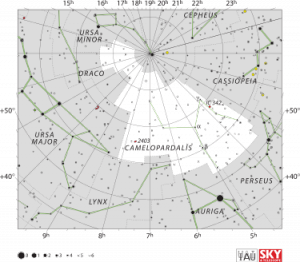Camelopardalis: Difference between revisions
No edit summary |
No edit summary |
||
| Line 2: | Line 2: | ||
[[Camelopardalis]] or the Giraffe constellation is a large, faint grouping of stars in the northern sky. The constellation was introduced in 1612 (or 1613) by Petrus Plancius. Some older astronomy books give an alternative spelling of the name, Camelopardus. Camelopardalis is in the part of the celestial sphere facing away from the galactic plane. Accordingly, many distant galaxies are visible within its borders. NGC 2403 is a galaxy in the [[Messier 81]] group of galaxies, located approximately 12 million light-years from Earth. | [[Camelopardalis]] or the Giraffe constellation is a large, faint grouping of stars in the northern sky. The constellation was introduced in 1612 (or 1613) by Petrus Plancius. Some older astronomy books give an alternative spelling of the name, Camelopardus. Camelopardalis is in the part of the celestial sphere facing away from the galactic plane. Accordingly, many distant galaxies are visible within its borders. NGC 2403 is a galaxy in the [[Messier 81]] group of galaxies, located approximately 12 million light-years from Earth. | ||
==Etymology== | |||
The giraffe's species name, camelopardalis (camelopard), is derived from its early Roman name where it was thought of as a composite creature, described as having characteristics of both a camel and a leopard. The word Giraffe is from Arabic dialectal zirafa, probably of African origin. | |||
"To the Romans, the giraffe was camelopardalis (camel marked like a leopard). The word giraffecomes from the Arabic zarafa. As a verb it means to jump or to hurry, leading to the noun one who walks swiftly. It has also been traced to an Ethiopian word that denotes graceful one. But its primary derivation, in the opinion of linguistic authority, stems from a source meaning assemblage, as in assemblage of animals. The Greeks were more specific: they contributed its scientific name, camelopardalis (or the more common, camelopard), which literally describes a camel's body wearing a leopard's coat". [Tall Blondes, Lynn Sherr, p.16.] | |||
"The Egyptians used a hieroglyph in the shape of a giraffe to indicate 'to prophecy', 'to foretell', which has been taken as evidence of its keen eyesight. Ancient Arabic words include saraphah, gyrapha,gyraffa, and zirafa. The Persians called it ushturgao ("camel-cow"). To the Chaldeans it was deba, andana, which may be related to nabun, used by Pliny. The encyclopedist Vincent de Beauvais, in hisSpeculum Naturale (1225), described it under three different names (anabulla, camelopardo, andorasius), apparently without realizing it. Albertus Magnus repeated the mistake in his thirteenth-centuryDe Animalibus, using anabula, camelopardulus, and oraflus. Anabula probably comes from the Ethiopians, who called it nabin; and orafle was used in Old French. In Afrikaans it is called kameelperd. and in Zulu indlulamethi. But my personal favorite is the Swahili word twiga—which sounds the way a giraffe looks. [Tall Blondes, Lynn Sherr, p.19.] <ref>[http://www.constellationsofwords.com/Constellations/Camelopardalis.htm Constellations of Words]</ref> | |||
Revision as of 21:28, 14 March 2015
Camelopardalis or the Giraffe constellation is a large, faint grouping of stars in the northern sky. The constellation was introduced in 1612 (or 1613) by Petrus Plancius. Some older astronomy books give an alternative spelling of the name, Camelopardus. Camelopardalis is in the part of the celestial sphere facing away from the galactic plane. Accordingly, many distant galaxies are visible within its borders. NGC 2403 is a galaxy in the Messier 81 group of galaxies, located approximately 12 million light-years from Earth.
Etymology
The giraffe's species name, camelopardalis (camelopard), is derived from its early Roman name where it was thought of as a composite creature, described as having characteristics of both a camel and a leopard. The word Giraffe is from Arabic dialectal zirafa, probably of African origin. "To the Romans, the giraffe was camelopardalis (camel marked like a leopard). The word giraffecomes from the Arabic zarafa. As a verb it means to jump or to hurry, leading to the noun one who walks swiftly. It has also been traced to an Ethiopian word that denotes graceful one. But its primary derivation, in the opinion of linguistic authority, stems from a source meaning assemblage, as in assemblage of animals. The Greeks were more specific: they contributed its scientific name, camelopardalis (or the more common, camelopard), which literally describes a camel's body wearing a leopard's coat". [Tall Blondes, Lynn Sherr, p.16.] "The Egyptians used a hieroglyph in the shape of a giraffe to indicate 'to prophecy', 'to foretell', which has been taken as evidence of its keen eyesight. Ancient Arabic words include saraphah, gyrapha,gyraffa, and zirafa. The Persians called it ushturgao ("camel-cow"). To the Chaldeans it was deba, andana, which may be related to nabun, used by Pliny. The encyclopedist Vincent de Beauvais, in hisSpeculum Naturale (1225), described it under three different names (anabulla, camelopardo, andorasius), apparently without realizing it. Albertus Magnus repeated the mistake in his thirteenth-centuryDe Animalibus, using anabula, camelopardulus, and oraflus. Anabula probably comes from the Ethiopians, who called it nabin; and orafle was used in Old French. In Afrikaans it is called kameelperd. and in Zulu indlulamethi. But my personal favorite is the Swahili word twiga—which sounds the way a giraffe looks. [Tall Blondes, Lynn Sherr, p.19.] [1]
HGS Session References
HGS Sessions - Clearing Hyperspace Phantom Matrix - 3/12/2015 [2]
References
Found in HGS Manual on Page 108
Found in HGS Manual on Page 115


